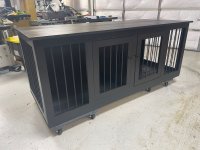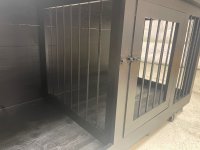HowardH
Member
The lady who cuts my hair also knows i do some woodworking so she asked me to build this kennel for her two dogs. Note to self. The plans called for using dimensional hardwood. I should have used cabinet grade plywood. I would have gone together a bit better and been easier to finish.
[attachimg=1]
[attachimg=2]
I posted this on FB and as it turns out, an old workmate of mine, posted this version that her daughter and SIL built. I don't have the heart to tell them what's wrong...
[attachimg=3]
I used some Soss 101 hinges with creating the mortices with a Shape Origin and they came out perfect.
[attachimg=1]
[attachimg=2]
I posted this on FB and as it turns out, an old workmate of mine, posted this version that her daughter and SIL built. I don't have the heart to tell them what's wrong...
[attachimg=3]
I used some Soss 101 hinges with creating the mortices with a Shape Origin and they came out perfect.




